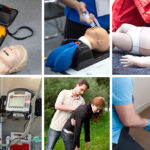How quickly or slowly do you need to do CPR? – Find out all about CPR rate in this article.
Truth is that anything can happen — emergency situations can occur anytime, anywhere. In case of a situation where one is a victim of cardiac arrest, there must be someone who can attend to them. The big question is about the CPR rate.
Online first aid and CPR classes serve as a good source of knowledge about administering CPR. Although the classes guide on how to do CPR, only a few mention the rate of push per minute. Is there any maximum rate for doing CPR? Is it safe to compress the chest too fast during CPR? Yes, you can push on the chest too fast. Read on to know more.
Pumping the Chest Fast
Heart specialists advise rescuers to pump the chest fast when performing CPR. This changed from a perception of a maximum of 100 pushes per minute to at least 100 pushes per minute. The people attending to victims are advised to press up to the full depth of the chest and recoil on each push.
Later there came another guideline recommending 100 to 200 compressions per minute. This was supported by the fact that the faster the compressions the higher the rate of blood flow, hence allowing the heart to fill the chest cavity.
Before performing CPR, check the following:
- Is the environment safe for both you and the victim?
- The victim’s state of consciousness
Compressions to Restore Blood Circulation
1.Put the victim horizontally on the back
2.Push the chest cavity with your palms straight up and down at least 2 inches.Push hard at a rate of 100 to 120 compressions per 60 seconds
3.Continue with the CPR until signs of improvement are observed
Recommended CPR Rate
It is confirmed that rates of 120 to 140 lead to the greatest chances of normal blood circulation. Successful CPR does not depend on one component alone. At rates above 120, the chest recoil is increasingly incomplete. Having shallow compressions limit the chances of successful CPR. It is important to allow complete chest recoil without removing the hands from the chest. The average compression ratio for an adult is 30:2 — implying provision of two rescue breaths after 30 compressions while maintaining a steady rhythm. In case of more than one person attending to the victim, the same guideline should be followed to increase the chances of a successful CPR. This also enables the person(s) attending to the victim to rest from the physically tiresome job of compressing.
Is the rate the same for infants?
This is a question that comes into our minds. Is the average CPR rate for adults the same as that for children and infants? The answer is No. The average rate for children and infants is 15:2. During emergency situations in children, victims require special medical attention as an effect of drowning or choking.
Benefits of Having CPR Knowledge
CPR saves a life. CPR knowledge helps one to attend to a victim in the case of an emergency. This helps save the lives of the victims.
Most cardiac arrests occur at a place of work and at home. In such situations, those with CPR knowledge help in saving the life of their loved ones.
It is a good decision for one to take online first aid and CPR classes so as to be equipped with both basic and professional knowledge. American CPR Care Association offers online and blended CPR courses.
How quickly or slowly do you need to do CPR, find out all about CPR rate in this article.
Truth is that anything can happen — emergency situations often occur. In case of a situation where one is a victim of cardiac arrest, there must be someone who will attend to them. You’ve heard of chest compressions, but how fast?
Online first aid and CPR classes serve as a good source of knowledge about administering CPR. Although the classes guide on how to do CPR, it can be difficult to remember a specific rate months down the line and you may find yourself wondering: Is there any maximum rate for doing CPR? Is it safe to compress the chest too fast during CPR? Yes, you can push on the chest too fast. Read on to know more.
Pumping the Chest Fast
Heart specialists advise rescuers to pump the chest fast when performing CPR. Previously a maximum rate of 100 pushes per minute was accepted but has since been revised up to a minimum of 100 pushes per minute. The people attending to victims are advised to press up to the full depth of the chest and recoil on each push.
Later there came another guideline recommending 100 to 200 compressions per minute. This was supported by the fact that the faster the compressions the higher the rate of blood flow, hence allowing the heart to fill the chest cavity. Successful CPR does not depend on one component alone. It is confirmed that rates of 120 to 140 lead to the greatest chances of normal blood circulation. At rates above 120, the chest recoil is increasingly incomplete. Having shallow compressions limit the chances of successful CPR. It is important to allow complete chest recoil without removing the hands from the chest.
Recommended CPR Rate
When administering CPR a rate of 100-120 beats per minute is recommended, but a raw number can be hard to remember. Some popular songs that have appropriate tempo that are commonly suggested to pump along to are BeeGee’s classic disco hit “Staying Alive” or Queen’s “Another One Bites the Dust”. The American Heart Association partnered with Spotify to create a playlist of songs to help you keep the beat.
The average compression ratio for an adult is 30:2 — implying provision of two rescue breaths after 30 compressions while maintaining a steady rhythm. If you are untrained in CPR it is recommended that you do not attempt rescue breathing and provide 100-120 bpm cycles for sixty seconds at a time continuously until help arrives. In case of more than one person attending to the victim, the same guideline should be followed to increase the chances of a successful CPR. This also enables the person(s) attending to the victim to rest from the physically tiresome job of compressing.
Is the rate the same for infants?
This is a question that comes into our minds. Is the average CPR rate for adults the same as that for children and infants? For infants there should be 15 compressions for every two breaths, and the chest should be compressed to a depth of 1.5 inches with two fingers. During emergency situations in children, victims require special medical attention as an effect of drowning or choking.
Benefits of Having CPR Knowledge
CPR saves a life. CPR knowledge helps one to attend to a victim in the case of an emergency. This helps save the lives of the victims.
Most cardiac arrests occur at home or in a workplace. In such situations, those with CPR knowledge help in saving the life of their loved ones.
Conclusion
It is a good decision for one to take online first aid and CPR classes to be equipped with both basic and professional knowledge. American CPR Care Association offers online and blended CPR courses.







